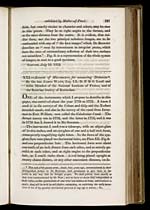James Watt (1736-1819)
Account of micrometers for measuring distances
exhibited by Mother-of-Pearl
121
faint, but exactly similar in character and colour, may be seen
in thin pieces. They lie at right angles to the former, and
at the same distance from the centre. It is evident, that nei-
ther these, nor the two principal nebulous images, are to be
confounded with any of “the four images” which Dr Brewster
describes as “seen by transmission in irregular pieces, which
have the axes of extraordinary reflection of their two surfaces
not coincident.” Fig. 6. is a representation of the whole system
of images as seen in a good specimen.
SLOUGH, July 12. 1819.
_______________________________________________
XXI.―Account of Micrometers for measuring Distances *.
By the late JAMES WATT, Esq. LL. D.F.R.S. Lond. and
Edin. Member of the National Institue of France, and of
the Batavian Society of Rotterdam.
ONE of the instruments which I propose to describe in this
paper, was contrived about the year 1770 or 1771. I know I
used it in the surveys of the Crinan and Gilp and the Tarbert
intended canals, and also in the survey of the canal from Inver-
ness to Fort William, now called the Caledonian Canal. The
former survey was in 1772, and the latter in 1773, and it was
in 1772 that I showed it to Mr Smeaton.
The instrument I used was a telescope, with an object-glass
of twelve inches, and an eye-glass of one and a half inch focus,
consequently magnifying eight times. In the focus of the eye-
glass there were placed two horizontal hairs, see Plate III. Fig.8.
and one perpendicular hair. The horizontal hairs were about
one-tenth of an inch distant from each other, and as strictly pa-
rallel to each other, and at right angles to the perpendicular
hair, as I could make them. A rod being placed upright at
twenty chains distant, or any other convenient distance, on le-
_______________________________________________
* This and other papers were, about four years ago, communicated by their
distinguished author to Dr Brewster, with permission to give them to the
public in any way that he thought proper. We shall publish them exactly as
they were communicated by Mr Watt; and we have no doubt that, independent of
their value, as the productions of one who has written so little, and invented so
much, they will be held in still higher estimation, as exhibiting the early inven-
tions of one of the greatest mechanical geniuses of any age or nation.―ED.


